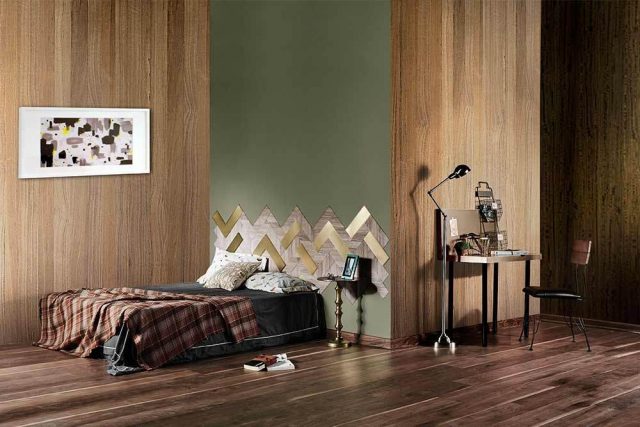Texture is more than a surface detail — it’s a design element that adds depth, dimension, and character to any space. Whether it’s the rustic charm of open-grain wood or the refined elegance of smooth finishes, surface texture helps define the mood of a room. In contemporary interiors, wood veneer has emerged as a material of choice for both aesthetic appeal and sustainable functionality. More specifically, textured wood veneer offers a unique blend of visual richness and tactile comfort — making it a favourite among architects, interior designers, and homeowners alike. If you’re working with engineered wood furniture or designing custom-built pieces, choosing the right veneer texture can elevate your space from functional to truly sophisticated.
What is Textured Wood Veneer?
At its core, wood veneer is a thin slice of real wood, applied to a substrate like plywood or MDF. While smooth veneers deliver a sleek finish, textured wood veneers bring a layered sensory experience — offering both visual and tactile engagement.
Texturing techniques involve brushing, embossing, or leaving open grains exposed to enhance the natural feel of wood. These textures not only highlight the grain patterns but also introduce a sense of depth to furniture and walls.
Also Read: Explore the Different Variants of Engineered Wood Veneers For Furniture
Common types of textured veneers include:
- Brushed finish: Soft linear grooves that mimic weathered wood.
- Rough-cut texture: A rustic, natural appearance with uneven grain.
- Embossed patterns: Intricate textures pressed onto the surface for added dimension.
- Open-grain finish: Retains the wood’s natural pores for a more organic look.
Each texture serves a distinct design purpose — whether you want understated elegance or bold visual drama.
Matching Veneers to Interior Themes and Furniture Styles
When selecting veneers for furniture, texture should harmonise with your design concept. The wrong surface finish can clash with your interiors, while the right texture can enhance harmony and flow.
Here’s how to match veneer textures to different styles:
- Modern and minimalist spaces: Choose brushed or fine-grain textures that offer subtle detailing without overwhelming the design.
- Rustic or industrial interiors: Opt for rough-cut or open-grain finishes that complement exposed materials like brick and metal.
- Classic luxury themes: Go for rich, elegant grains like walnut texture, which adds warmth and timeless sophistication.
Textured veneers also pair seamlessly with engineered wood furniture, bringing authenticity and natural flair to modular designs without compromising structural stability.
Design Benefits of Decorative Veneer Sheets
Beyond their visual charm, decorative veneer sheets offer multiple practical advantages that make them a go-to material in modern design projects.
Key benefits include:
- Aesthetic versatility: Available in a wide range of grains, colours, and finishes to suit varied design preferences.
- Lightweight application: Easier to handle and apply than solid wood panels.
- Consistent finish: High uniformity across sheets ensures visual coherence.
- Sustainability: Requires less wood than solid lumber, reducing deforestation impact.
Textured veneer sheets, in particular, help break visual monotony and introduce a tactile dimension that flat surfaces simply cannot replicate.
Choosing the Right Texture – What to Consider
The selection process for textured wood veneer goes beyond personal taste. Several practical factors should guide your decision:
- Lighting: Coarse textures cast shadows, creating depth — ideal for well-lit spaces. Finer grains suit dimly lit areas.
- Room size: Subtle textures work better in compact rooms, while bolder textures can define larger spaces.
- Functionality: In high-traffic zones, choose textures that are easy to maintain and resist visible wear.
- Colour scheme: Darker textures like walnut texture pair well with warm tones, while lighter textures suit pastel or neutral palettes.
Finally, always work with established veneer manufacturers in India who can guarantee quality, durability, and ethical sourcing practices.
Popular Textured Veneers in Modern Design
Designers across India are embracing textured veneer finishes, adding personality and depth to their projects. Some textures consistently rank high in popularity:
- Walnut texture: A rich, mid-to-dark grain that conveys understated luxury — perfect for wardrobes, headboards, and accent walls.
- Brushed oak veneer: Delivers a soft, linear texture ideal for Scandinavian or contemporary interiors.
- Embossed patterns: Great for creating focal points on cabinetry or panels.
- Open-grain finishes: A natural, earthy feel that complements biophilic or rustic design themes.
These textures not only enhance visual appeal but also contribute to a multisensory design experience that feels grounded and timeless.
Also Read: Versatility Unveiled: Why Engineered Wood Veneer Excels in Diverse Applications
About Mikasa Decowood Veneers
Mikasa Decowood Veneers, a premium brand from Greenlam Industries, is a leading name among veneer manufacturers in India, known for its exceptional craftsmanship and wide range of decorative veneer sheets. From refined walnut textures to contemporary textured wood veneer designs, Mikasa Decowood Veneers brings nature’s beauty into engineered applications with unmatched quality and innovation. Explore the finest selection of veneers to elevate your furniture and interiors with elegance and character. To discuss your requirement, call 1800 833 0004 or email info@mikasaveneers.com . You may also fill out our contact form.

